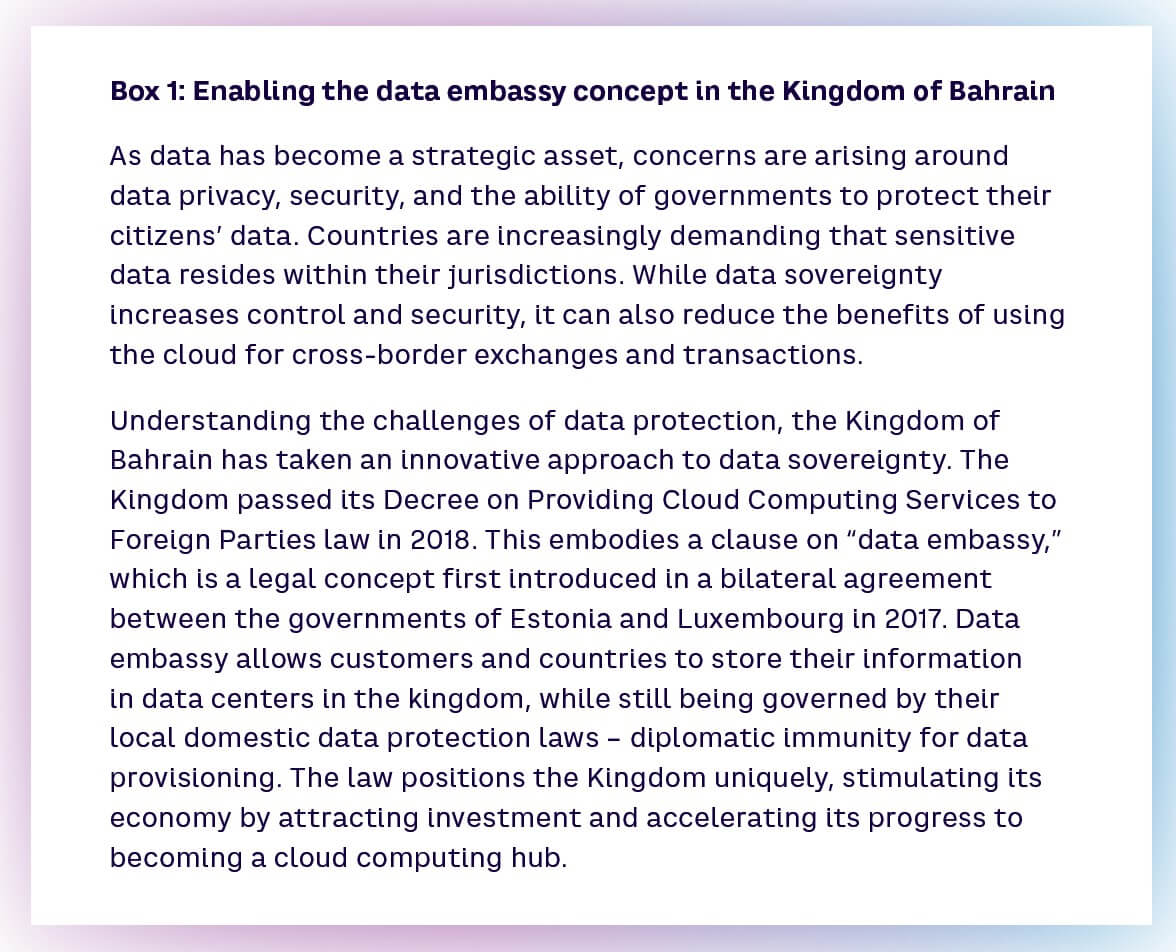Charting the course
Navigating the journey to national digital economy transformation

At a country level, digitalization is seen as a driver of economic growth and skilled jobs creation. While the term “digital economy” is not new, recent developments mean policy makers must now rethink their digitalization agendas.
Firstly, digitalization has become a critical factor in maintaining economic competitiveness, as it permeates all economic sectors, disrupting traditional production and exchanges and creating new growth opportunities. Digitalization is no longer optional – those that don’t adopt it risk falling behind.
Secondly, data has become a strategic asset, with the insights unlocked by AI and machine learning creating sustained competitive advantage for businesses and individuals while enabling policy makers to make more informed, evidence-based decisions.
Thirdly, rapid technology evolution needs to be balanced with ethical considerations. For example, algorithmic bias and tech-driven job displacement are prompting discussions on the societal impact of technology in terms of fairness, equity, and inclusivity. Additionally, the use of data to train generative AI models has ignited concerns around IP ownership and the need to rethink national data protection policies.
Fourthly, the climate emergency is driving a need for radical action to meet net-zero commitments. Digitalization both enables decarbonization (such as through process optimization) and plays a key role in measuring, monitoring, and reporting on national progress towards net zero.
Finally, the digital economy is becoming an international, pan-government undertaking with geopolitical ramifications. Policy makers must find a balance between digital sovereignty over technology, IP ownership, and data protection and governance. International cooperation is necessary to harmonize digital regulations and facilitate cross-border data flows and digital trade agreements.
Based on insights from an exhaustive global benchmark of digital economy progress, this article explores how countries should react to these developments. They need to adopt a holistic approach to a nation’s digitalization that benefits sectors of interest and builds national differentiation and global competitiveness. They must understand the importance of each of the building blocks of digitalization and how they interrelate. Overall, nations need to adopt a collaborative and agile approach to maximize digitalization’s benefits and mitigate any potential risks.
The link between the digital economy and economic growth
Digitalization delivers significant economic benefits through its positive impact on productivity, employment, and innovation. This is true across different country maturity levels – while digitalization can transform developing nations, it can also accelerate new services and innovation within developed countries, as economies such as Estonia, Singapore, and the US show.
Our global benchmark demonstrates that digitalized economies achieve higher productivity levels and faster economic growth than their peers, as shown in Figure 1,[1] which reveals a high correlation (R2 = 0.47) between digital transformation and GDP per capita levels. The International Labour Organization (ILO)[2] has estimated that the economic multiplier of digital investments is more than double that of other investments, delivering USD 3.79 versus USD 1.52 for each USD 1 spent.
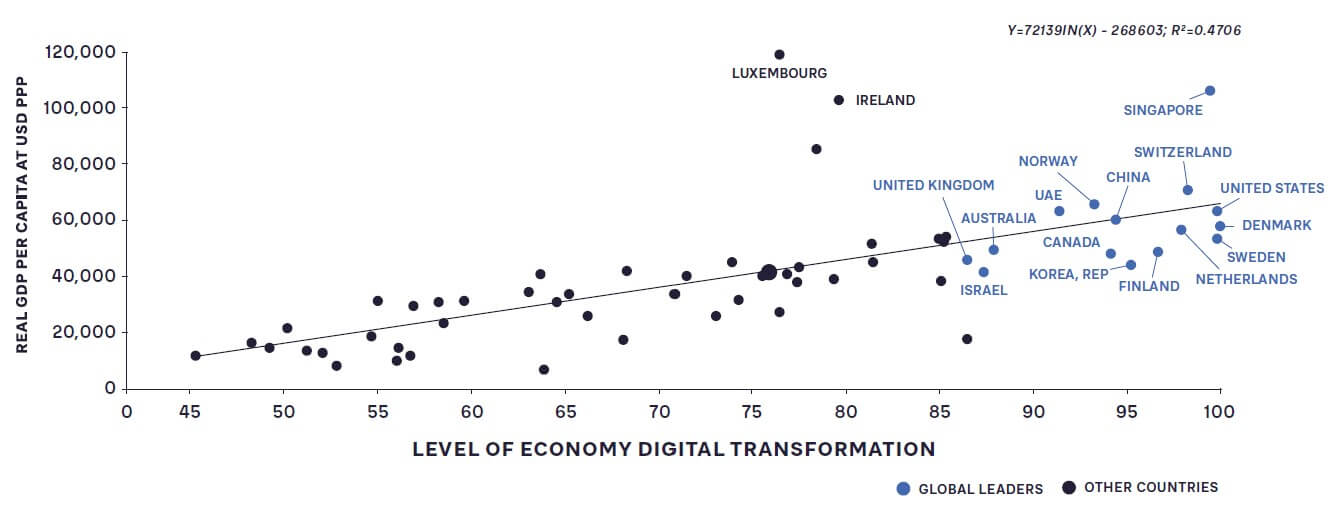
Governments have seen the importance of building digital economies for many years. However, it has risen in importance in support of advancing national development agendas due to the growing need for digitalization across the economy; an enormous increase in data volumes across all sectors, especially when coupled with AI; ethical considerations; the need to achieve net-zero targets; and the requirement to balance digital sovereignty and international cooperation.
Meeting the challenges of creating a digital economy
Building a national digital economy is a large-scale program spanning many dimensions, involving many stakeholders, and lasting many years. Achieving ongoing success requires countries to focus on overcoming three key challenges, related to:
-
Regulations: A balance is needed between the extremes of over-regulation and taking a laissez-faire approach. Governments need to adopt innovative regimes, such as sandboxes where experimentation can occur without regulatory constraints.
-
Funding: Digital economy projects, particularly those of an enabling nature, require significant investment. Governments should consider alternative sources of funding, such as public-private partnerships (PPPs) and structuring monetization models for services. For example, Indian banks and telcos use government data-exchange systems to perform electronic verification checks on new customers, generating revenues for the platform itself.
-
Capabilities: The skills required to digitalize, including programming, cloud computing, AI/data analytics, and cybersecurity capabilities, are in high demand across the globe. Governments must therefore invest in developing capabilities through education and training, while also attracting and maintaining such talent. Over the last 20 years, Singapore has embedded ICT in its educational curriculum, for example, helping nurture much-needed skills, while Estonia has launched a range of measures, including a comprehensive digital talent attraction program that goes beyond dedicated visas.
A national digital economy framework – a roadmap towards digitalizing economic exchanges and output
On the path to transforming their economies through digitalization, nations need to work holistically from vision to action. Analysis of our benchmark research, coupled with our experience, shows six critical elements to transforming an economy though digitalization, as set out in Figure 2.
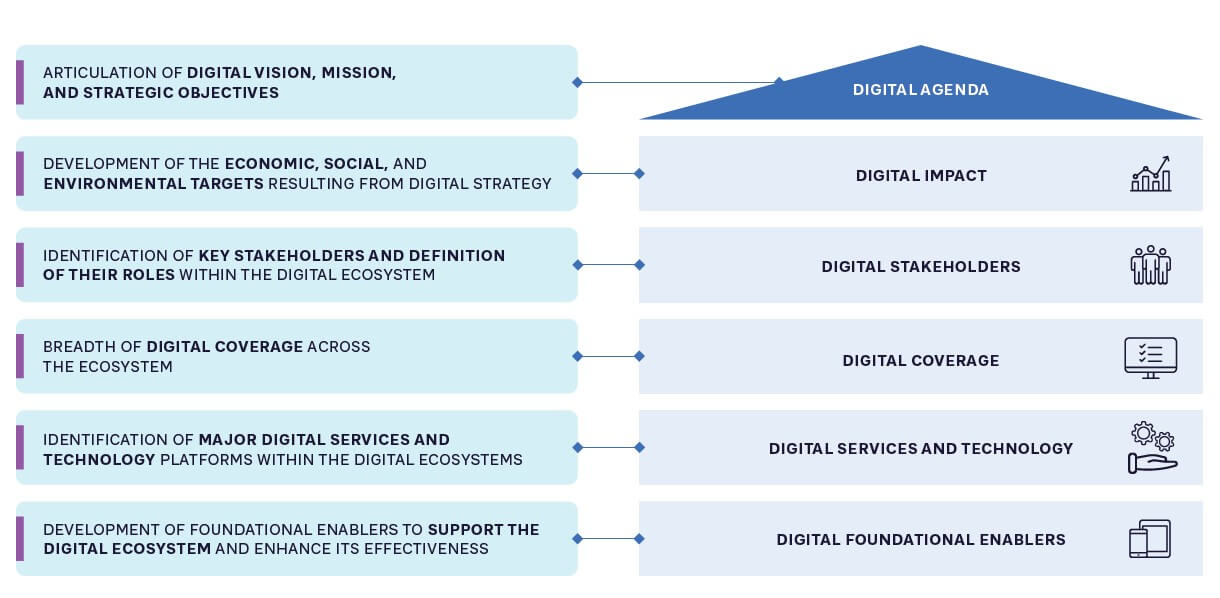
1. Digital Agenda
Start by defining an overall vision and strategic objectives. This vision acts as the North Star, steering all national efforts in one direction, while the objectives are measurable, achievable, and time-bound milestones on the journey. Digital Agenda setting is a critical element, as it allows policy makers to identify national priorities with the highest impact, allocate resources efficiently, and provide a common understanding and purpose to all relevant stakeholders, maximizing the chances of success. For example, Australia has created one of the world’s most comprehensive and actionable digital economy strategies, built on the objective of creating a modern, leading digital economy by 2030.[3]
2. Digital Impact
Digital impact is then derived from the vision, reflecting the desired outcomes and aspirations. Specifically, this entails defining the targets to be achieved:
-
Economic targets: such as achieving higher economic growth, enhancing national productivity levels, and creating new jobs
-
Social targets: achieving more inclusive economic growth with enhanced access to improved and more efficient public services (such as education, health, and pensions)
-
Environmental targets: reducing emissions and waste, supporting climate change efforts, and empowering sustainable practices across economic sectors
Digital Impact allows countries to measure, evaluate, and communicate the effectiveness of their digitalization efforts, demonstrating value and enhancing accountability. South Korea is a strong example of comprehensive target setting, being one of the few countries that has put environmental issues at the heart of its New Deal digital program.[4]
3. Digital Stakeholders
Identifying key stakeholders and defining their roles in the digital economy agenda are vital, particularly around the four areas of governance:
-
Overarching strategy governance
-
Sectorial digitalization
-
Functional digitalization
-
Enablement
Assigning clear roles and responsibilities guarantees commitment and accountability. It facilitates effective coordination, avoids duplication, and fosters synergies, such as around knowledge exchange and resource pooling. By identifying and involving relevant stakeholders, policy makers can ensure that sector-specific needs are addressed. In turn, stakeholders play a crucial role in shaping the vision, providing insights, and working together to achieve set objectives.
In Singapore, the Smart Nation and Digital Government Office (SNDGO) spearheads the implementation of digitalization initiatives and reports directly to the Prime Minister’s Office. SNDGO has appointed dedicated digital officers in each ministry to act as a focal point for coordination. These officers ensure that initiatives are aligned with broader national digitalization objectives, while also acting as a point of contact for stakeholders within the ministry.
In addition to national stakeholders, policy makers need to engage internationally, fostering cooperation around areas such as harmonizing digital regulations and digital trade agreements.
4. Digital Coverage
Depending on Digital Impact objectives, nations need to define key priority sectors and create specific plans. These sector-specific strategies cascade overall national digital economy goals and align with sector priorities, outline the government’s role, and set policies and incentives.
The Digital Coverage element is crucial as each sector has unique characteristics, requiring tailored sectorial digitalization policies that allow stakeholders to work together more effectively across the value chain. For example, the Danish Digital Health Strategy addressed specific healthcare focus areas, including streamlining information flows between patients and healthcare professionals, while emphasizing security and privacy.
5. Digital Services and Technology
Programs need to develop key technology platforms and digital services that connect ecosystems and enable the seamless exchange of information, services, and goods. These Digital Public Goods (DPGs) and Digital Public Infrastructures (DPIs) include horizontal platforms such as digital ID, ePayment, eRegistries, eInvoicing, and data exchanges, as well as vertical sector-specific platforms such as national drug registration and inventory systems in the healthcare sector. For a more detailed look at DPGs and DPIs, refer to Digital Public Goods – The benefits for citizens, governments, and businesses, elsewhere in this issue of Prism.
Technology should be agile and interoperable, as well as meet the highest levels of data privacy and cybersecurity to instill trust and confidence, while creating a level playing field for businesses.
Identification and deployment of digital services and technologies is a critical element of the framework, as it empowers individuals and businesses to access information, connect with others, carry out transactions, etc., leading to increased productivity and convenience. The availability and adoption of interoperable horizontal and vertical digital services and technology platforms also underpin sector digitization.
Furthermore, the data gathered from digital services provisioning allows for evidence-based decision-making, provides insights for course correction or refinement of digital impact objectives, and fosters continuous improvement of sectorial policies and initiatives.
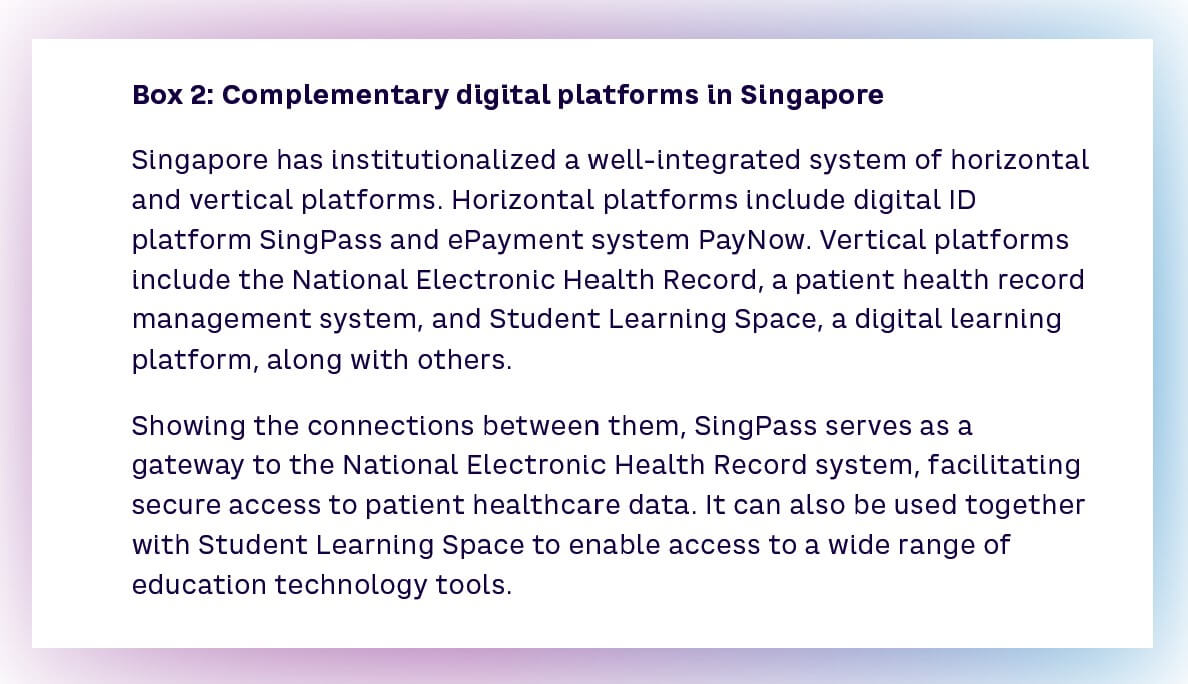
6. Digital Foundational Enablers
Foundational Enablers support the development of a digital ecosystem and enhance its effectiveness. They include developing a robust education and life-long learning system to guarantee the future readiness of human talent, ensuring the availability of financial capital, creating an enabling entrepreneurship and innovation ecosystem, and crafting a conducive legal and regulatory environment. Digital Foundational Enablers underpin the end-to-end digitalization journey and overcome key regulatory, funding, and capability challenges:
-
Clear and adaptive regulations build trust and confidence, encouraging innovation and investment while safeguarding the interests of stakeholders.
-
Focused education initiatives foster employability, inclusion, and entrepreneurship.
-
Infrastructure investments facilitate deployment of digital technologies and development of innovative digital services that benefit citizens and businesses.
For example, New Zealand’s latest digital strategy emphasizes upskilling and digital inclusion to empower people and organizations to pursue digitalization. It was driven by government research indicating that skills gaps were the main barriers to digital enablement among New Zealand businesses.
Insights for the executive
When embarking on national economy transformation through digitalization, policy makers need to view the process holistically, following seven best practices:
1. Make digitalization efforts central to a nation’s strategic agenda
The digital economy is not just about the ICT sector. More importantly, it is an enabler across the economy and society at large. Overall, digital economy strategies must consider this enablement role of technology, as well as align digitalization priorities with existing sectorial strategies and plans.
2. Focus on strong governance
When implementing a national digital agenda, policy makers are often faced with resistance to change. They therefore must institutionalize governance structures that facilitate collaboration, communication, and recognition among stakeholders, as well as assign a lead entity with overarching authority to drive implementation.
3. Take a holistic, systematic view
To be able to design effective policies, policy makers need to think holistically and understand the root cause of a problem and its ramifications for other initiatives. Digitalization efforts are unlikely to yield meaningful results without a plan that considers and effectively integrates interdependencies between the different elements of the digital ecosystem.
4. Involve the private sector
As the key engine of economic growth, the private sector has a crucial role in the transformation journey. Policy makers need to keep an open dialogue with businesses, tapping into their innovation capabilities and involving them actively in both strategic planning and implementation.
5. Adopt an experimentation mind-set
Digital success requires agility and readiness to experiment, taking measured risks and learning from failures – all behaviors that are not typical in a policy-making setting. Adopting an iterative approach with quick feedback loops is crucial for digital and non-digital solutions to be adapted to changing circumstances, as well as to ensure efforts are successfully focused.
6. Don’t reinvent the wheel
Learn from the experiences of others and adapt existing strategies and technologies to meet your specific needs. Building on successful programs from other countries and regions can accelerate and de-risk your own digitalization strategies, maximizing ROI.
7. Don’t neglect long-term foundational enablers
The benefits of foundational enablers such as ICT education take time to be realized. This may make taking “quick-win” measures more attractive. However, failing to invest in these enablers will undermine the pillars of the digital economy, making it unsustainable over time.
Notes
[1] IMD, World Bank
[2] Changing demand for skills in digital economies and societies, ILO2

Charting the course
Navigating the journey to national digital economy transformation

DATE

At a country level, digitalization is seen as a driver of economic growth and skilled jobs creation. While the term “digital economy” is not new, recent developments mean policy makers must now rethink their digitalization agendas.
Firstly, digitalization has become a critical factor in maintaining economic competitiveness, as it permeates all economic sectors, disrupting traditional production and exchanges and creating new growth opportunities. Digitalization is no longer optional – those that don’t adopt it risk falling behind.
Secondly, data has become a strategic asset, with the insights unlocked by AI and machine learning creating sustained competitive advantage for businesses and individuals while enabling policy makers to make more informed, evidence-based decisions.
Thirdly, rapid technology evolution needs to be balanced with ethical considerations. For example, algorithmic bias and tech-driven job displacement are prompting discussions on the societal impact of technology in terms of fairness, equity, and inclusivity. Additionally, the use of data to train generative AI models has ignited concerns around IP ownership and the need to rethink national data protection policies.
Fourthly, the climate emergency is driving a need for radical action to meet net-zero commitments. Digitalization both enables decarbonization (such as through process optimization) and plays a key role in measuring, monitoring, and reporting on national progress towards net zero.
Finally, the digital economy is becoming an international, pan-government undertaking with geopolitical ramifications. Policy makers must find a balance between digital sovereignty over technology, IP ownership, and data protection and governance. International cooperation is necessary to harmonize digital regulations and facilitate cross-border data flows and digital trade agreements.
Based on insights from an exhaustive global benchmark of digital economy progress, this article explores how countries should react to these developments. They need to adopt a holistic approach to a nation’s digitalization that benefits sectors of interest and builds national differentiation and global competitiveness. They must understand the importance of each of the building blocks of digitalization and how they interrelate. Overall, nations need to adopt a collaborative and agile approach to maximize digitalization’s benefits and mitigate any potential risks.
The link between the digital economy and economic growth
Digitalization delivers significant economic benefits through its positive impact on productivity, employment, and innovation. This is true across different country maturity levels – while digitalization can transform developing nations, it can also accelerate new services and innovation within developed countries, as economies such as Estonia, Singapore, and the US show.
Our global benchmark demonstrates that digitalized economies achieve higher productivity levels and faster economic growth than their peers, as shown in Figure 1,[1] which reveals a high correlation (R2 = 0.47) between digital transformation and GDP per capita levels. The International Labour Organization (ILO)[2] has estimated that the economic multiplier of digital investments is more than double that of other investments, delivering USD 3.79 versus USD 1.52 for each USD 1 spent.
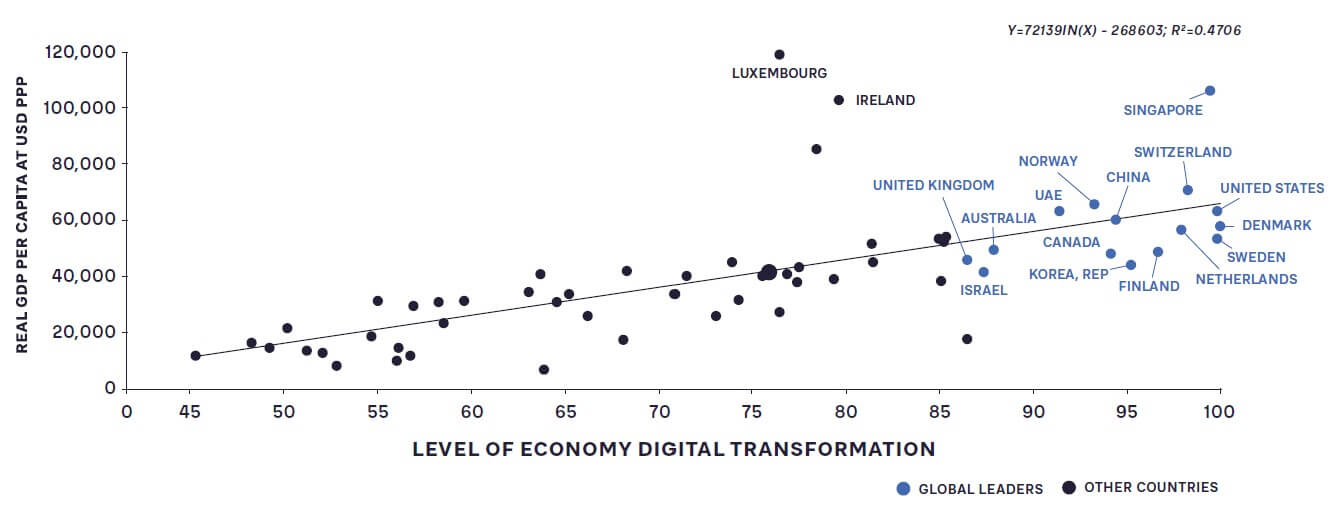
Governments have seen the importance of building digital economies for many years. However, it has risen in importance in support of advancing national development agendas due to the growing need for digitalization across the economy; an enormous increase in data volumes across all sectors, especially when coupled with AI; ethical considerations; the need to achieve net-zero targets; and the requirement to balance digital sovereignty and international cooperation.
Meeting the challenges of creating a digital economy
Building a national digital economy is a large-scale program spanning many dimensions, involving many stakeholders, and lasting many years. Achieving ongoing success requires countries to focus on overcoming three key challenges, related to:
-
Regulations: A balance is needed between the extremes of over-regulation and taking a laissez-faire approach. Governments need to adopt innovative regimes, such as sandboxes where experimentation can occur without regulatory constraints.
-
Funding: Digital economy projects, particularly those of an enabling nature, require significant investment. Governments should consider alternative sources of funding, such as public-private partnerships (PPPs) and structuring monetization models for services. For example, Indian banks and telcos use government data-exchange systems to perform electronic verification checks on new customers, generating revenues for the platform itself.
-
Capabilities: The skills required to digitalize, including programming, cloud computing, AI/data analytics, and cybersecurity capabilities, are in high demand across the globe. Governments must therefore invest in developing capabilities through education and training, while also attracting and maintaining such talent. Over the last 20 years, Singapore has embedded ICT in its educational curriculum, for example, helping nurture much-needed skills, while Estonia has launched a range of measures, including a comprehensive digital talent attraction program that goes beyond dedicated visas.
A national digital economy framework – a roadmap towards digitalizing economic exchanges and output
On the path to transforming their economies through digitalization, nations need to work holistically from vision to action. Analysis of our benchmark research, coupled with our experience, shows six critical elements to transforming an economy though digitalization, as set out in Figure 2.

1. Digital Agenda
Start by defining an overall vision and strategic objectives. This vision acts as the North Star, steering all national efforts in one direction, while the objectives are measurable, achievable, and time-bound milestones on the journey. Digital Agenda setting is a critical element, as it allows policy makers to identify national priorities with the highest impact, allocate resources efficiently, and provide a common understanding and purpose to all relevant stakeholders, maximizing the chances of success. For example, Australia has created one of the world’s most comprehensive and actionable digital economy strategies, built on the objective of creating a modern, leading digital economy by 2030.[3]
2. Digital Impact
Digital impact is then derived from the vision, reflecting the desired outcomes and aspirations. Specifically, this entails defining the targets to be achieved:
-
Economic targets: such as achieving higher economic growth, enhancing national productivity levels, and creating new jobs
-
Social targets: achieving more inclusive economic growth with enhanced access to improved and more efficient public services (such as education, health, and pensions)
-
Environmental targets: reducing emissions and waste, supporting climate change efforts, and empowering sustainable practices across economic sectors
Digital Impact allows countries to measure, evaluate, and communicate the effectiveness of their digitalization efforts, demonstrating value and enhancing accountability. South Korea is a strong example of comprehensive target setting, being one of the few countries that has put environmental issues at the heart of its New Deal digital program.[4]
3. Digital Stakeholders
Identifying key stakeholders and defining their roles in the digital economy agenda are vital, particularly around the four areas of governance:
-
Overarching strategy governance
-
Sectorial digitalization
-
Functional digitalization
-
Enablement
Assigning clear roles and responsibilities guarantees commitment and accountability. It facilitates effective coordination, avoids duplication, and fosters synergies, such as around knowledge exchange and resource pooling. By identifying and involving relevant stakeholders, policy makers can ensure that sector-specific needs are addressed. In turn, stakeholders play a crucial role in shaping the vision, providing insights, and working together to achieve set objectives.
In Singapore, the Smart Nation and Digital Government Office (SNDGO) spearheads the implementation of digitalization initiatives and reports directly to the Prime Minister’s Office. SNDGO has appointed dedicated digital officers in each ministry to act as a focal point for coordination. These officers ensure that initiatives are aligned with broader national digitalization objectives, while also acting as a point of contact for stakeholders within the ministry.
In addition to national stakeholders, policy makers need to engage internationally, fostering cooperation around areas such as harmonizing digital regulations and digital trade agreements.
4. Digital Coverage
Depending on Digital Impact objectives, nations need to define key priority sectors and create specific plans. These sector-specific strategies cascade overall national digital economy goals and align with sector priorities, outline the government’s role, and set policies and incentives.
The Digital Coverage element is crucial as each sector has unique characteristics, requiring tailored sectorial digitalization policies that allow stakeholders to work together more effectively across the value chain. For example, the Danish Digital Health Strategy addressed specific healthcare focus areas, including streamlining information flows between patients and healthcare professionals, while emphasizing security and privacy.
5. Digital Services and Technology
Programs need to develop key technology platforms and digital services that connect ecosystems and enable the seamless exchange of information, services, and goods. These Digital Public Goods (DPGs) and Digital Public Infrastructures (DPIs) include horizontal platforms such as digital ID, ePayment, eRegistries, eInvoicing, and data exchanges, as well as vertical sector-specific platforms such as national drug registration and inventory systems in the healthcare sector. For a more detailed look at DPGs and DPIs, refer to Digital Public Goods – The benefits for citizens, governments, and businesses, elsewhere in this issue of Prism.
Technology should be agile and interoperable, as well as meet the highest levels of data privacy and cybersecurity to instill trust and confidence, while creating a level playing field for businesses.
Identification and deployment of digital services and technologies is a critical element of the framework, as it empowers individuals and businesses to access information, connect with others, carry out transactions, etc., leading to increased productivity and convenience. The availability and adoption of interoperable horizontal and vertical digital services and technology platforms also underpin sector digitization.
Furthermore, the data gathered from digital services provisioning allows for evidence-based decision-making, provides insights for course correction or refinement of digital impact objectives, and fosters continuous improvement of sectorial policies and initiatives.

6. Digital Foundational Enablers
Foundational Enablers support the development of a digital ecosystem and enhance its effectiveness. They include developing a robust education and life-long learning system to guarantee the future readiness of human talent, ensuring the availability of financial capital, creating an enabling entrepreneurship and innovation ecosystem, and crafting a conducive legal and regulatory environment. Digital Foundational Enablers underpin the end-to-end digitalization journey and overcome key regulatory, funding, and capability challenges:
-
Clear and adaptive regulations build trust and confidence, encouraging innovation and investment while safeguarding the interests of stakeholders.
-
Focused education initiatives foster employability, inclusion, and entrepreneurship.
-
Infrastructure investments facilitate deployment of digital technologies and development of innovative digital services that benefit citizens and businesses.
For example, New Zealand’s latest digital strategy emphasizes upskilling and digital inclusion to empower people and organizations to pursue digitalization. It was driven by government research indicating that skills gaps were the main barriers to digital enablement among New Zealand businesses.
Insights for the executive
When embarking on national economy transformation through digitalization, policy makers need to view the process holistically, following seven best practices:
1. Make digitalization efforts central to a nation’s strategic agenda
The digital economy is not just about the ICT sector. More importantly, it is an enabler across the economy and society at large. Overall, digital economy strategies must consider this enablement role of technology, as well as align digitalization priorities with existing sectorial strategies and plans.
2. Focus on strong governance
When implementing a national digital agenda, policy makers are often faced with resistance to change. They therefore must institutionalize governance structures that facilitate collaboration, communication, and recognition among stakeholders, as well as assign a lead entity with overarching authority to drive implementation.
3. Take a holistic, systematic view
To be able to design effective policies, policy makers need to think holistically and understand the root cause of a problem and its ramifications for other initiatives. Digitalization efforts are unlikely to yield meaningful results without a plan that considers and effectively integrates interdependencies between the different elements of the digital ecosystem.
4. Involve the private sector
As the key engine of economic growth, the private sector has a crucial role in the transformation journey. Policy makers need to keep an open dialogue with businesses, tapping into their innovation capabilities and involving them actively in both strategic planning and implementation.
5. Adopt an experimentation mind-set
Digital success requires agility and readiness to experiment, taking measured risks and learning from failures – all behaviors that are not typical in a policy-making setting. Adopting an iterative approach with quick feedback loops is crucial for digital and non-digital solutions to be adapted to changing circumstances, as well as to ensure efforts are successfully focused.
6. Don’t reinvent the wheel
Learn from the experiences of others and adapt existing strategies and technologies to meet your specific needs. Building on successful programs from other countries and regions can accelerate and de-risk your own digitalization strategies, maximizing ROI.
7. Don’t neglect long-term foundational enablers
The benefits of foundational enablers such as ICT education take time to be realized. This may make taking “quick-win” measures more attractive. However, failing to invest in these enablers will undermine the pillars of the digital economy, making it unsustainable over time.
Notes
[1] IMD, World Bank
[2] Changing demand for skills in digital economies and societies, ILO2
